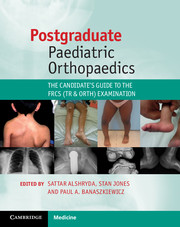Book contents
- Frontmatter
- Contents
- List of contributors
- Foreword
- Preface
- Acknowledgements
- Interactive website
- List of abbreviations
- Section 1 General guidance
- Section 2 Core structured topics
- Chapter 3 The hip
- Chapter 4 The knee
- Chapter 5 The foot and ankle
- Chapter 6 The spine
- Chapter 7 The shoulder
- Chapter 8 The elbow
- Chapter 9 Congenital hand deformities
- Chapter 10 Neuromuscular diseases
- Chapter 11 Musculoskeletal infections
- Chapter 12 Musculoskeletal tumours
- Chapter 13 Skeletal dysplasia
- Chapter 14 Metabolic bone disease
- Chapter 15 Physis and leg length discrepancy
- Chapter 16 Deformity corrections
- Chapter 17 Miscellaneous paediatric conditions
- Section 3 Exam-related material
- Index
- References
Chapter 10 - Neuromuscular diseases
Published online by Cambridge University Press: 05 August 2014
- Frontmatter
- Contents
- List of contributors
- Foreword
- Preface
- Acknowledgements
- Interactive website
- List of abbreviations
- Section 1 General guidance
- Section 2 Core structured topics
- Chapter 3 The hip
- Chapter 4 The knee
- Chapter 5 The foot and ankle
- Chapter 6 The spine
- Chapter 7 The shoulder
- Chapter 8 The elbow
- Chapter 9 Congenital hand deformities
- Chapter 10 Neuromuscular diseases
- Chapter 11 Musculoskeletal infections
- Chapter 12 Musculoskeletal tumours
- Chapter 13 Skeletal dysplasia
- Chapter 14 Metabolic bone disease
- Chapter 15 Physis and leg length discrepancy
- Chapter 16 Deformity corrections
- Chapter 17 Miscellaneous paediatric conditions
- Section 3 Exam-related material
- Index
- References
Summary
Recognizing ‘normal’
In any paediatric orthopaedic examination, it is vital that progress in achieving developmental milestones is evaluated. Familiarity with the normal will alert the examiner to the abnormal.
Mobility and ambulation
Approximately 90% of normally developing infants are able to:
Roll themselves by 6 months,
Sit without support by 8 months,
Pull themselves up to stand by 10 months,
Walk by 15 months,
Hop on one foot by 4 years.
Note, however, that 10% of children will normally achieve these milestones later, but failure to walk by 2 years of age should be investigated.
A normal toddler gait is wide-based and stiff-kneed. A mature ‘adult’ gait, with its characteristic reciprocal arm swing, develops from 3.5 years onward.
Upper-limb development
Transfer of objects between hands: normally from 8 months,
Opposition and release of objects: from 1 year,
Proper grasp and release: 18 months,
Finger-grip to hold a crayon: 2 years,
Writing: from 4 to 5 years.
The following red flags should prompt further evaluation:
Not rolling over by 6 months,
Not sitting by 8 months,
Handedness before 12 months,
No words by 14 months,
Not walking by 18 months.
- Type
- Chapter
- Information
- Postgraduate Paediatric OrthopaedicsThe Candidate's Guide to the FRCS (Tr and Orth) Examination, pp. 165 - 179Publisher: Cambridge University PressPrint publication year: 2014



